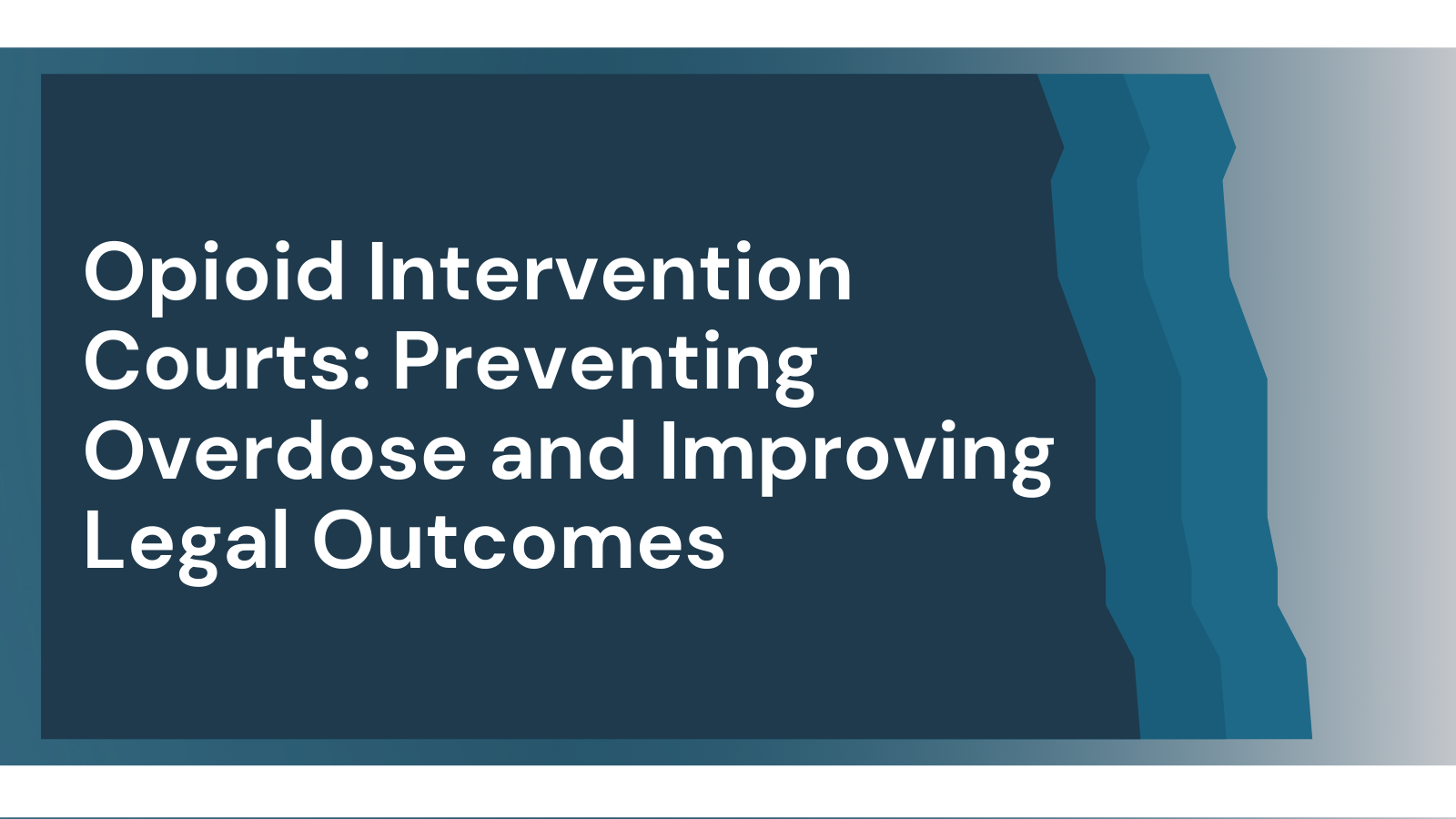When people with opioid use disorder (OUD) participate in drug court, research shows that they are far less likely to graduate than people with other substance use disorders, making them more vulnerable to lethal overdoses. In 2017, a week of multiple fatal opioid overdoses by individuals awaiting second appearances in traditional drug court prompted the establishment of the first Opioid Intervention Court (OIC) in Buffalo, New York. This judicially supervised triage program offers immediate screening and life-saving intervention (including medications for OUD [MOUD]), without waiting until cases are adjudicated or otherwise resolved in court.
This emphasis on timeliness is a fundamental difference in practice from traditional drug courts, where assessment and treatment typically occur after a plea and where entry into treatment may only be available days, weeks, or months after initial arraignment, depending upon the court calendar and availability of the appropriate treatment provider. According to the National Treatment Court Resource Center, 37 OICs operate nationwide (see Figure 1).
Distinct Characteristics
The ten essential elements of OICs—as identified by a working group of justice system practitioners, subject-matter experts, researchers, and government officials—help jurisdictions adopt best practices for preventing overdose and saving lives. Distinctions between OICs and traditional drug courts within these elements include the following:
- Rapid clinical assessment and treatment engagement.
- Broad legal eligibility. People facing criminal charges who have OUD or for whom opioids are the drug of choice are eligible for OIC.* To make the life-saving services of the court available to as many participants as possible, OICs strive to accept the broadest possible range of charges, both misdemeanors and felonies. Access to traditional drug courts is often restricted to those deemed to be at high risk of criminogenic activity as well as a high need for treatment. The OIC is primarily concerned with the prevention of opioid overdose.
Figure 1: Number of OICs per State
| State | # OICs |
|---|---|
| Arizona | 3 |
| Florida | 1 |
| Nevada | 2 |
| New York | 29 |
| Pennsylvania | 1 |
| Wisconsin | 1 |
- Suspension of prosecution or expedited plea. OIC suspends the legal process to allow the participant to focus immediately on stabilization and treatment. In contrast, drug court participation generally begins after a plea or finding in the individual’s case or after an agreement is made among all parties in lieu of adjudication.
- Recovery support services. Peer recovery support staff are considered integral to the success of OIC programs. These staff are people in recovery from addiction who are trained to engage participants in treatment, provide peer support, and connect them with additional recovery resources in the community. Family support navigators (trained staff who have family members affected by substance use disorders) may also be available to assist participants’ family members. Traditional drug courts may or may not include peer recovery support, although this has become more widespread in recent years, particularly among drug courts receiving federal grants.
- Frequent judicial supervision and compliance monitoring. The OIC judge, who is trained in motivational interviewing and other clinical engagement techniques, meets with participants every weekday during the duration of the program (typically, a minimum of 90 days) to engage in an honest discussion about their progress. Another feature of OIC supervision is that, while frequent urine screening is required, positive results do not trigger sanctions. While drug courts also include judicial monitoring and periodic court reviews, they are far less intensive, meeting weekly initially and less often as the program progresses. Abstinence is a condition of participation; positive urine screens may generate more intensive treatment but may also result in sanctions or termination.
- Program completion and continuing care. OIC participants receive no commitment from the court or prosecutor that completion of the program will result in a specific court outcome. Depending on the charges and circumstances, the prosecutor may drop or lower the charges or decide to proceed with prosecution. Participants may enter into plea agreements after program completion, allowing them to be diverted into other programs promoting long-term recovery; others may be sentenced to jail, prison, or probation. This contrasts with traditional drug courts, where typically there is an agreement that prosecution will be dropped if the participant completes the required treatment.
Addressing Implementation Challenges
An evaluation report of the Buffalo OIC notes a 50-percent drop in the death rate among opioid users, lower recidivism, and societal cost savings of more than $300,000 per participant.
However, bringing the OIC model to scale is not without its challenges. Several implementation barriers have been identified, including a lack of formalized procedures within courts. Because the model is relatively new and in so few locations, there is a lack of information on practices and policies. Guidance is emerging: How to Implement an Opioid Intervention Court provides a step-by-step checklist aligned with the 10 Essential Elements of Opioid Intervention Courts and is based on lessons learned from Buffalo’s OIC.
Another barrier to implementation involves access to MOUD, which is considered integral to OIC but has long been burdened by stigma. Misconceptions among court staff, SUD treatment providers, and clients can hamper the uptake of and engagement in programming. Incorporating Medication in Opioid Courts: Reducing Overdose Through Triage in Treatment Court Settings describes quality MOUD care and identification of both potential court participants and MOUD providers.
Limited OUD services are a third barrier to OIC implementation, which is particularly felt in rural areas. Opioid use is more common among adults in nonmetro areas, especially those that are completely rural, than in metro areas. Rural judges and sheriffs cite the lack of treatment and recovery support services as a primary challenge to addressing the opioid crisis. However, as the authors of the study on implementation barriers note, settlement funds coming into states due to opioid-related lawsuits may expand options for treatment, including telehealth.
Improving access to peers and recovery support systems through technology is a strategy developed through a Comprehensive Opioid, Stimulant, and Substance Use Program (COSSUP)* grant awarded to the New York State Unified Court System (NYS UCS). This Bureau of Justice Assistance funding supports the infrastructure, planning, and implementation of OICs in eight U.S. Department of Agriculture-designated rural counties of New York State, which were identified through regular monitoring of the Overdose Detection Mapping Application Program as having higher than state and national averages of overdose rates. Other strategies include the following:
- Identifying major stakeholders and existing resources essential to community engagement and operation through Sequential Intercept Mapping
- Partnering with the Medication for Addiction Treatment and Electronic Referral (MATTERS) network to facilitate rapid referrals to outpatient treatment for OUD
- Pioneering solutions to transportation challenges associated with getting participants to treatment and court appointments, such as partnering with local transportation and Uber Health
NYS UCS is also planning a New York OIC Center for Excellence to present best practices for addressing the high risk of overdose, provide an online portal for OICs to exchange information, and moderate an OIC Implementation Learning Community.
Conclusion
OICs hold significant promise for jurisdictions seeking to deal with the devastation of the opioid epidemic, allowing them to address the urgent clinical needs of individuals with OUD in a manner that promotes recovery, thereby interrupting the cycle of continued substance use and contact with the criminal justice system. The model’s essential elements can be tailored to best fit the nuances of each community.
* Drug courts that receive federal funding are not permitted to use grant funds to serve those prosecuted for violent crimes.
* Formerly known as the Comprehensive Opioid, Stimulant, and Substance Abuse Program.
Like what you’ve read? Sign up to receive the monthly GAINS eNews!


